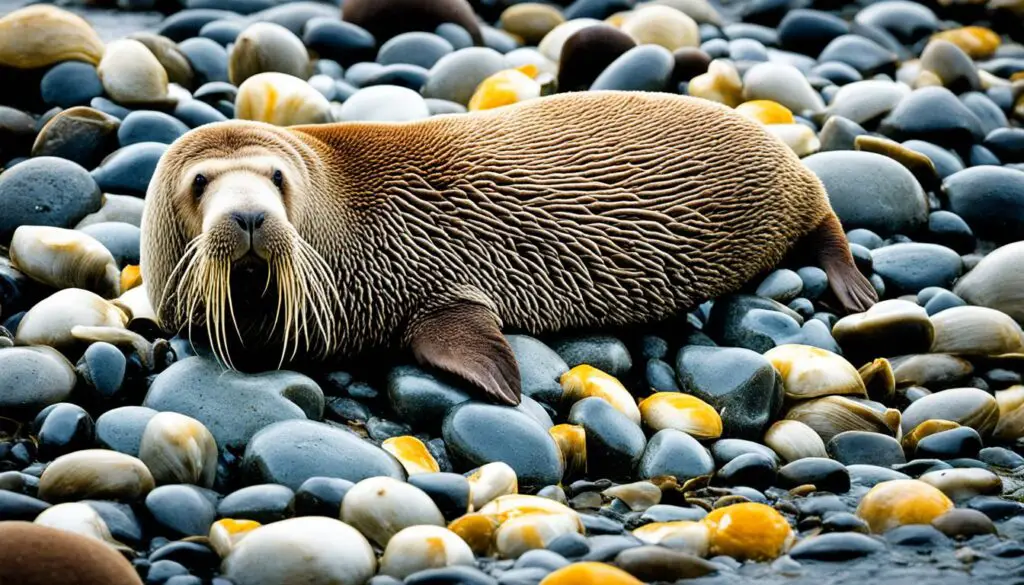Walruses are fascinating marine mammals that live in the Arctic and sub-Arctic. They are classified as Odobenus rosmarus. Knowing what they eat helps us understand their role in their environment. Let’s explore what walruses eat and how they interact with their habitat.
Walruses mainly eat marine invertebrates. They love to eat mollusks, especially clams. Their unique traits and behaviors show how they hunt and feed. This is important for keeping their numbers stable in the wild.
Understanding Walrus Diet
Walruses mainly eat benthic invertebrates from the ocean floor. They prefer soft-bodied animals that are easy to eat. Their diet includes clams, worms, snails, and crustaceans, which are key for their health.
It’s vital for walruses to eat these invertebrates. What they eat affects their health and energy. As the seasons change, walruses change how they hunt to find food.
Knowing what walruses like to eat helps us understand how they survive. They can live in different places because they adapt their eating habits.
| Component | Description | Importance |
|---|---|---|
| Clams | Soft-bodied bivalves found in abundance | Primary source of nutrition |
| Worms | Includes various species living in the ocean floor | Rich in protein |
| Snails | Common prey item, providing essential fats | Supports energy needs |
| Crustaceans | Includes shrimp and other small marine animals | Important for balanced diet |
What do walruses eat?
Walruses eat a wide variety of foods because they need lots of calories. Their diet shows what they prefer to eat and why. It helps us understand their eating habits in the wild.
Key Components of Their Diet
The main foods in a walrus’s diet are:
- Mollusks: They love to eat different types of mollusks, especially clams.
- Crustaceans: Sometimes, they also eat crustaceans like crabs.
- Fish: Fish is not their main food but they eat it sometimes.
These foods show how walruses adapt to their environments. They eat a lot of clams, which give them a lot of energy. In one meal, they can eat up to 6,000 clams, showing how they forage for food.
Why Bivalves are Favorited
Walruses like bivalves for several reasons:
- Abundance: Bivalves are easy to find in many places where walruses live.
- Nutritional Value: They give walruses the nutrients they need for energy.
- Soft Texture: Bivalves are soft, making them easy to eat compared to harder foods.
This shows how much walruses rely on bivalves in their diet. It also shows how their diet meets their needs and fits their role in nature.

Walrus Feeding Habits Explained
Walruses have unique ways of finding food in the ocean. They use their sensitive whiskers to search for prey hidden in the sand. This helps them find bivalves and other invertebrates, which are a big part of their diet.
Walruses eat at least twice a day. Their eating habits change with the seasons and how much food is available. When they move to new places, they might eat more or less. This affects their health and how many babies they have.
Walruses can dive deep to find food. They mainly eat mollusks. Their diet changes with the environment. In winter, they have to find food under the ice because of the sea ice.
Learning about how walruses eat helps scientists understand them better. It shows why we need to protect their homes for their survival.
Walrus Food Preferences
Understanding what walruses eat is key to knowing their role in the ocean. They mainly eat mollusks and other invertebrates. These foods are easy to find and full of nutrients that keep them healthy. Clams are their top choice, but they also eat sea cucumbers and krill for variety.
Mollusks and Other Invertebrates
Mollusks are a big part of a walrus’s diet. They use their whiskers to find invertebrates on the ocean floor. This shows how well they can hunt for food. They eat a lot to meet their energy needs, which helps keep their home ecosystem balanced.
Occasional Seal Consumption
Walruses usually stick to eating mollusks but can change their diet when needed. In times when food is scarce, big male walruses might eat seals. This shows how they can adapt to survive and how complex their eating habits are. It also shows how they fit into the ocean’s ecosystem.
FAQ
What is the primary diet of walruses?
Walruses mainly eat marine invertebrates. They love to eat mollusks, especially clams. These make up a big part of their diet.
How many clams can a walrus eat in one feeding session?
In one sitting, a walrus can eat between 3,000 to 6,000 clams. This shows how much they forage for food.
What other foods do walruses eat apart from clams?
Besides clams, walruses also eat sea cucumbers, krill, snails, worms, and sometimes fish and crustaceans. They eat these when clams are hard to find.
How do walruses find their food?
Walruses use their sensitive whiskers to find prey in murky waters. They search among and under the ocean floor’s sediments.
How often do walruses eat?
Walruses usually eat twice a day. But, they can eat more or less depending on how much food is available and the season.
Why do walruses prefer bivalves in their diet?
Walruses like bivalves because they are plentiful, soft, and nutritious. These qualities are important for their big energy needs.
Do walruses ever eat seals?
Yes, when there’s not much food around, some big male walruses eat seals. This shows they can change their eating habits when needed.







